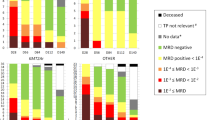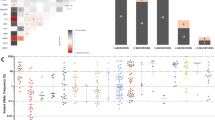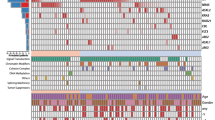Abstract
A standardized, sensitive and universal method for minimal residual disease (MRD) detection in acute myeloid leukemia (AML) is still pending. Although hyperexpression of Wilms' tumor (WT1) gene transcript has been frequently proposed as an MRD marker in AML, wide comparability of the various methods used for evaluating WT1 expression has not been given. We established and standardized a multicenter approach for quantifying WT1 expression by quantitative reverse transcriptase PCR (qRT-PCR), on the basis of a primer/probe set combination at exons 6 and 7. In a series of quality-control rounds, we analyzed 69 childhood AML samples and 47 normal bone marrow (BM) samples from 4 participating centers. Differences in the individual WT1 expressions levels ranged within <0.5 log of the mean in 82% of the cases. In AML samples, the median WT1/1E+04 Abelson (ABL) expression was 3.5E+03 compared with that of 2.3E+01 in healthy BM samples. As 11.5% of childhood AML samples in this cohort harbored WT1 mutations in exon 7, the effect of mutations on WT1 expression has been investigated, showing that mutated cases expressed significantly higher WT1 levels than wild-type cases. Hence, our approach showed high reproducibility and applicability, even in patients with WT1 mutations; therefore, it can be widely used for the quantitation of WT1 expression in future clinical trials.
This is a preview of subscription content, access via your institution
Access options
Subscribe to this journal
Receive 12 print issues and online access
$259.00 per year
only $21.58 per issue
Buy this article
- Purchase on Springer Link
- Instant access to full article PDF
Prices may be subject to local taxes which are calculated during checkout





Similar content being viewed by others
References
Cilloni D, Saglio G . WT1 as a universal marker for minimal residual disease detection and quantification in myeloid leukemias and in myelodysplastic syndrome. Acta Haematol 2004; 112: 79–84.
Lapillonne H, Renneville A, Auvrignon A, Flamant C, Blaise A, Perot C et al. High WT1 expression after induction therapy predicts high risk of relapse and death in pediatric acute myeloid leukemia. J Clin Oncol 2006; 24: 1507–1515.
Weisser M, Kern W, Rauhut S, Schoch C, Hiddemann W, Haferlach T et al. Prognostic impact of RT-PCR-based quantification of WT1 gene expression during MRD monitoring of acute myeloid leukemia. Leukemia 2005; 19: 1416–1423.
Barragan E, Cervera J, Bolufer P, Ballester S, Martin G, Fernandez P et al. Prognostic implications of Wilms' tumor gene (WT1) expression in patients with de novo acute myeloid leukemia. Haematologica 2004; 89: 926–933.
Steinbach D, Schramm A, Eggert A, Onda M, Dawczynski K, Rump A et al. Identification of a set of seven genes for the monitoring of minimal residual disease in pediatric acute myeloid leukemia. Clin Cancer Res 2006; 12: 2434–2441.
Hollink IH, Zwaan CM, Zimmermann M, Arentsen-Peters TC, Pieters R, Cloos J et al. Favorable prognostic impact of NPM1 gene mutations in childhood acute myeloid leukemia, with emphasis on cytogenetically normal AML. Leukemia 2009; 23: 262–270.
Keilholz U, Menssen HD, Gaiger A, Menke A, Oji Y, Oka Y et al. Wilms' tumour gene 1 (WT1) in human neoplasia. Leukemia 2005; 19: 1318–1323.
Yang L, Han Y, Suarez SF, Minden MD . A tumor suppressor and oncogene: the WT1 story. Leukemia 2007; 21: 868–876.
Trka J, Kalinova M, Hrusak O, Zuna J, Krejci O, Madzo J et al. Real-time quantitative PCR detection of WT1 gene expression in children with AML: prognostic significance, correlation with disease status and residual disease detection by flow cytometry. Leukemia 2002; 16: 1381–1389.
Cilloni D, Gottardi E, De Micheli D, Serra A, Volpe G, Messa F et al. Quantitative assessment of WT1 expression by real time quantitative PCR may be a useful tool for monitoring minimal residual disease in acute leukemia patients. Leukemia 2002; 16: 2115–2121.
Ostergaard M, Olesen LH, Hasle H, Kjeldsen E, Hokland P . WT1 gene expression: an excellent tool for monitoring minimal residual disease in 70% of acute myeloid leukaemia patients - results from a single-centre study. Br J Haematol 2004; 125: 590–600.
Osborne D, Frost L, Tobal K, Yin JAL . Elevated levels of WT1 transcripts in bone marrow harvests are associated with a high relapse risk in patients autografted for acute myeloid leukaemia. Bone Marrow Transplant 2005; 36: 67–70.
Tamaki H, Ogawa H, Ohyashiki K, Ohyashiki JH, Iwama H, Inoue K et al. The Wilms' tumor gene WT1 is a good marker for diagnosis of disease progression of myelodysplastic syndromes. Leukemia 1999; 13: 393–399.
Bader P, Niemeyer C, Weber G, Coliva T, Rossi V, Kreyenberg H et al. WT1 gene expression: useful marker for minimal residual disease in childhood myelodysplastic syndromes and juvenile myelo-monocytic leukemia? Eur J Haematol 2004; 73: 25–28.
Cilloni D, Gottardi E, Messa F, Fava M, Scaravaglio P, Bertini M et al. Significant correlation between the degree of WT1 expression and the International Prognostic Scoring System Score in patients with myelodysplastic syndromes. J Clin Oncol 2003; 21: 1988–1995.
Hamalainen MM, Kairisto V, Juvonen V, Johansson J, Auren J, Kohonen K et al. Wilms tumour gene 1 overexpression in bone marrow as a marker for minimal residual disease in acute myeloid leukaemia. Eur J Haematol 2008; 80: 201–207.
Boublikova L, Kalinova M, Ryan J, Quinn F, O'Marcaigh A, Smith O et al. Wilms' tumor gene 1 (WT1) expression in childhood acute lymphoblastic leukemia: a wide range of WT1 expression levels, its impact on prognosis and minimal residual disease monitoring. Leukemia 2006; 20: 254–263.
Hollink IH, van den Heuvel-Eibrink MM, Zimmermann M, Balgobind BV, Arentsen-Peters ST, Alders M et al. Clinical relevance of Wilms' tumor 1 gene mutations in childhood acute myeloid leukemia. Blood 2009, January (e-pub ahead of print).
Paschka P, Marcucci G, Ruppert AS, Whitman SP, Mrozek K, Maharry K et al. Wilms Tumor 1 Gene Mutations Independently Predict Poor Outcome in Adults With Cytogenetically Normal Acute Myeloid Leukemia: A Cancer and Leukemia Group B Study. J Clin Oncol 2008; 26: 4595–4602.
Nyvold CG, Stentoft J, Braendstrup K, Melsvik D, Moestrup SK, Juhl-Christensen C et al. Wilms' tumor 1 mutation accumulated during therapy in acute myeloid leukemia: biological and clinical implications. Leukemia 2006; 20: 2051–2054.
Summers K, Stevens J, Kakkas I, Smith M, Smith LL, Macdougall F et al. Wilms' tumour 1 mutations are associated with FLT3-ITD and failure of standard induction chemotherapy in patients with normal karyotype AML. Leukemia 2007; 21: 550–551.
Virappane P, Gale R, Hills R, Kakkas I, Summers K, Stevens J et al. Mutation of the Wilms' Tumor 1 Gene Is a Poor Prognostic Factor Associated With Chemotherapy Resistance in Normal Karyotype Acute Myeloid Leukemia: The United Kingdom Medical Research Council Adult Leukaemia Working Party. J Clin Oncol 2008; 26: 5429–5435.
Gaidzik V, Dohner K . Prognostic implications of gene mutations in acute myeloid leukemia with normal cytogenetics. Semin Oncol 2008; 35: 346–355.
Pollard JA, Zeng R, Ho P, Alonzo T, Gerbing R, Stirewalt D et al. Prevalence and prognostic implications of WT1 mutations in pediatric AML Â: Report from Children's Oncology Group. Blood (ASH annual meeting abstracts) 2008; 112: 58.
Chomczynski P, Sacchi N . Single-step method of RNA isolation by acid guanidinium thiocyanate-phenol-chloroform extraction. Anal Biochem 1987; 162: 156–159.
Beillard E, Pallisgaard N, van der Velden VHJ, Bi W, Dee R, van der Schoot E et al. Evaluation of candidate control genes for diagnosis and residual disease detection in leukemic patients using ‘real-time’ quantitative reverse-transcriptase polymerase chain reaction (RQ-PCR) - a Europe Against Cancer program. Leukemia 2003; 17: 2474–2486.
Gabert J, Beillard E, van der Velden V, Bi W, Grimwade D, Pallisgaard N et al. Standardization and quality control studies of ‘real-time’ quantitative reverse transcriptase polymerase chain reaction of fusion gene transcripts for residual disease detection in leukemia - a Europe Against Cancer program. Leukemia 2003; 17: 2318–2357.
van Dongen JJM, Macintyre EA, Gabert JA, Delabesse E, Rossi V, Saglio G et al. Standardized RT-PCR analysis of fusion gene transcripts from chromosome aberrations in acute leukemia for detection of minimal residual disease - Report of the BIOMED-1 Concerted Action: Investigation of Minimal Residual Disease in Acute Leukemia. Leukemia 1999; 13: 1901–1928.
Kreuzer KA, Saborowski A, Lupberger J, Appelt C, Na IK, le Coutre P et al. Fluorescent 5′-exonuclease assay for the absolute quantification of Wilms' tumour gene (WT1) mRNA: implications for monitoring human leukaemias. Br J Haematol 2001; 114: 313–318.
Pallisgaard N, Hokland P, Bi WL, van der Schoot E, Watzinger F, Lion T et al. Selection of reference genes for the European standardization and quality control program of real-time quantitative RT-PCR analysis of fusion gene transcripts for minimal residual disease follow-up in leukemia patients. Blood 2001; 98: 192B.
Beillard E, Pradel V, Aerts J, Barbany G, Bi W, Cave H et al. European standardization and quality control program of real time quantitative RT-PCR analysis of fusion gene transcripts for minimal residual disease detection in leukemia patients. Leukemia 2001; 15: 2006–2007.
Gottardi E, Cilloni D, Daly S, Green S, Pallisgaard N, Hokland P et al. Standardization of WT1 mRNA quantification for minimal residual disease (MRD) monitoring in acute leukemia patients: a European LeukemiaNet concerted action. Blood (ASH annual meeting abstracts) 2005; 106: 3295.
van der Velden VH, Hochhaus A, Cazzaniga G, Szczepanski T, Gabert J, van Dongen JJ . Detection of minimal residual disease in hematologic malignancies by real-time quantitative PCR: principles, approaches, and laboratory aspects. Leukemia 2003; 17: 1013–1034.
The R Foundation for Statistical Computing c/o Institut für Statistik und Wahrscheinlichkeitstheorie der Technischen Universität Wien. R, a language and environment for statistical computing and graphics. University of Vienna, Austria, 2003.
Steinbach D, Debatin KM . What do we mean by sensitivity when we talk about detecting minimal residual disease? Leukemia 2008; 22: 1638–1639.
Acknowledgements
This work was supported by the ‘Deutsche José Carreras Leukämie Stiftung e.V. (DJCLS R04/09)’, Munich, Germany (PB, HK, AMW), by the ‘Research Project of the Czech Ministry of Education (No. 0021620813)’, Prague, Czech Republic (JT, MK), by the ‘Fondazione Tettamanti, Fondazione Cariplo and AIRC’, Italy (AB, GC) and by the ‘KOCR Foundation’, Rotterdam, The Netherlands (IHIMH, CMZ). We thank Vida Meyer (Frankfurt), Nadine Pfaffendorf (Jena), Vincenzo Rossi (Monza) and Patricia Hoogeveen (Rotterdam) for their excellent technical assistance.
Author information
Authors and Affiliations
Consortia
Corresponding author
Rights and permissions
About this article
Cite this article
Willasch, A., Gruhn, B., Coliva, T. et al. Standardization of WT1 mRNA quantitation for minimal residual disease monitoring in childhood AML and implications of WT1 gene mutations: a European multicenter study. Leukemia 23, 1472–1479 (2009). https://doi.org/10.1038/leu.2009.51
Received:
Revised:
Accepted:
Published:
Issue Date:
DOI: https://doi.org/10.1038/leu.2009.51
Keywords
This article is cited by
-
The prognostic significance of Wilms’ tumor gene 1 (WT1) expression at diagnosis in adults with Ph-negative B cell precursor acute lymphoblastic leukemia
Annals of Hematology (2019)
-
Real-time assessment of relapse risk based on the WT1 marker in acute leukemia and myelodysplastic syndrome patients after hematopoietic cell transplantation
Bone Marrow Transplantation (2015)
-
Detection of relapse after hematopoietic stem cell transplantation in childhood by monitoring of WT1 expression and chimerism
Journal of Cancer Research and Clinical Oncology (2015)
-
Surface Enhanced Raman Spectroscopy-Based Method for Leukemia Biomarker Detection Using Magnetic Core @ Gold Shell Nanoparticles
BioNanoScience (2014)
-
Bone marrow WT1 levels at diagnosis, post-induction and post-intensification in adult de novo AML
Leukemia (2013)



